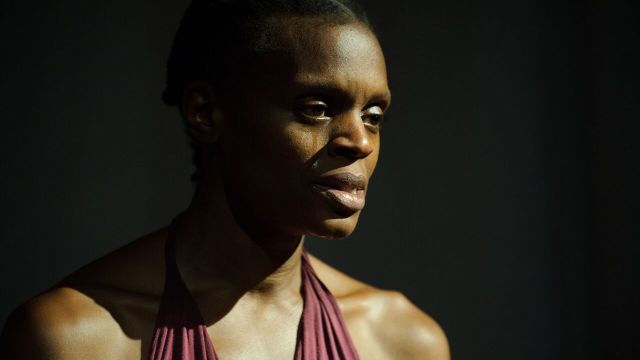Bronx Gothic
Okwui Okpokwasili is a tall, slim, rangy woman. Hers is the body of an athlete, perhaps from Somalia or the Sudan. She stands turned away in the corner of the performance space. (There is no stage, just a space, surrounded by translucent curtains.) She is moving, but we can’t see her face. She shakes, she quivers, she undulates, she trembles, she shivers. Sometimes her bare feet stomp and her knees almost buckle. Almost. Her long beautiful arms reach out, making fleeting gestures that seems for mere moments to suggest so many things: an offering, a prayer, supplication, warding off an attack… Just as fleetingly her hands move over her body, between her legs, holding something in, letting something out. What can this mean?
As we watch this - and only this - for about twenty minutes, and hear the sound of drums and children’s playground voices, we think of some imprisoned energy that strains to explode… but does not – and is exhausting. Finally, she turns to us. She is sheened with sweat. We see her face and it has a small smile. She is quite aware of having made us wait. And now she says, ‘There is something I got to tell you…’ The voice throws another contrast at us: it is urban Afro-American. That voice will tell us a story.
It is difficult to describe Bronx Gothic, let alone categorise it or say what it is ‘like’. It isn’t ‘like’ anything; it is itself. It merges dance, movement, text and performance. It has, however, a subject. I hope I don’t simplify something rich and complex, but at the centre is a friendship (already that’s too simple) over years between two women, a relationship that ebbs and flows in its balance of power, that can descend to vicious insult and rejection, and yet binds these women inexorably together. It is in a way, similar to the novels of Elena Farrante, but far more fraught, more dangerous, more raw.
It begins with an exchange of notes between two eleven-year-old girls. Eleven-year-old black girls in the Bronx. In a program note, Ms Okpokwasili says ‘It is not an autobiography. But it is my story. It is a homage and a cry.’
 The Narrator, so to speak, is the naïve and trusting girl asking questions of her worldly friend. As she reads the notes, Ms Okpokwasili ‘plays’ both girls with perfect clarity so that later, when there are no more notes, we still know who’s talking. What’s an orgasm feel like? The answer is almost poetic – it like waves but inside your body. What does cum taste like? Depends what he have for lunch. And so on. One girl describes a scarifying nightmare in which the world is hot as fire and then the fire is inside, ‘in her pussy’. It is as direct as that. It is so intimate, so honest that we are held, even if like some transfixed voyeur.
The Narrator, so to speak, is the naïve and trusting girl asking questions of her worldly friend. As she reads the notes, Ms Okpokwasili ‘plays’ both girls with perfect clarity so that later, when there are no more notes, we still know who’s talking. What’s an orgasm feel like? The answer is almost poetic – it like waves but inside your body. What does cum taste like? Depends what he have for lunch. And so on. One girl describes a scarifying nightmare in which the world is hot as fire and then the fire is inside, ‘in her pussy’. It is as direct as that. It is so intimate, so honest that we are held, even if like some transfixed voyeur.
This friendship is, it seems, one of those symbiotic relationships that cannot be escaped any more than the women can escape their place and their milieu. But they do escape – except that, years later, the Narrator must, has to find this cruel mentor… Her struggles are demonstrated too by a most amazing series of movements, her body prone but suspended, hand to hand, knee to knee… as if some force will neither let her escape nor rest.
The director and lighting designer is Peter Born, a frequent collaborator. I could not begin to say why his lighting works so well, but it does. The space is scattered with kitsch table lamps, figurines and plastic flowers. At times the light comes through the surrounding curtains, suggesting almost an undersea feeling. When Ms Okpokwasili reads the notes, she holds them under a single down light and her face is lost in shadow above. So the focus is these bits of notepaper (she destroyed the originals, but wrote them out again – she could, she knew them by heart, she had to) and those two voices.
And then, at the end of her ninety minutes alone on stage, having created two beings and their lives and contexts, Ms Okpokwasili takes her bow and, suddenly, this powerful, graceful, vulnerable woman is awkward, gauche, as if surprised by our applause. She has opened herself to us, but which is real?
Bronx Gothic is part of an on-going collaboration between Arts House in Melbourne and Performance Space 122 in New York City. In 2016 the traffic goes the other way: some samples of Melbourne art goes to NY.
Michael Brindley
Photoggrapher: Sarah Walker
Subscribe to our E-Newsletter, buy our latest print edition or find a Performing Arts book at Book Nook.

